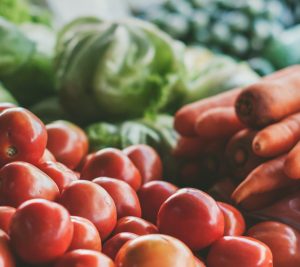Eating the recommended amount of fruits and vegetables every day can reduce your risk of chronic diseases, such as type-2 diabetes, cardiovascular disease, high blood pressure, and some types of cancers.
It can also play an important role in gastrointestinal health and vision. Most produce is nutrient-dense, packed with vitamins and minerals, low in calories, and a great source of fiber. Not only is it important to get enough fruits and vegetables daily, but eating a wide variety is the key to reaping the benefits of their nutrient power. Maximize your intake by choosing produce from all different colors of the spectrum!

The national recommendations (Choose My Plate) vary slightly based on age and gender. Generally, most adults need 2.5 to 3 cups of vegetables and 1.5 to 2 cups of fruit daily. To learn more about vegetable servings and subgroups, and more information on fruit servings and varieties, visit www.choosemyplate.gov.
Fruits, vegetables, whole grains, legumes and beans, herbs, spices, nuts and seeds are all rich sources of phytonutrients. Phytonutrients are a natural part of plants and are responsible for their many different colors, tastes, and smells. Getting a wide variety of different phytonutrients helps to provide our bodies with protection from cellular damage and can reduce the risk of some chronic diseases 2. To learn more about phytochemicals, antioxidants, and the different colors associated with each product, see www.ag.ndsu.edu (NDSU Extension Service).
Buying local produce “in season” not only supports local farmers and producers and saves you money, but also gives you the freshest and tastiest seasonally available choices. Learn which Florida produce is available during every month of the year at www.freshfromflorida.com
Whether it’s fresh, frozen, canned, dried, or 100% fruit juice, all forms count for good nutrition.


